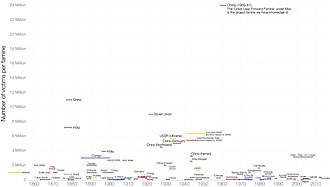List of famines in China
This is a list of famines in China. Between 108 BC and 1911 AD, there were no fewer than 1,828 recorded famines in China, or once nearly every year in one province or another. The famines varied in severity.[1][2]
.jpg)

Famines in China
| Name | Time | Region | Context | Estimated number of dead |
|---|---|---|---|---|
| 875–884 | Peasant rebellion in China inspired by famine; Huang Chao captured capital | |||
| 1333–1337[3] | Famine in China | |||
| 1630–1631 | Northwestern China | Eventually causing the Ming dynasty to collapse in 1644 | ||
| 1810, 1811, 1846, 1849 | Unknown (45 million decrease, unknown how many emigrated or avoided census to evade taxes)[4] | |||
| 1850–1873 | Nian Rebellion, Taiping Rebellion and drought | Primarily caused by famine, lower life expectancy and plague in the case of the Nian rebellion, the total war casualties are claimed to possibly be 10–30 million people[5][6] | ||
| Great North China Famine | 1876–1879 | Northern China | Drought | 9–13 million[7] |
| 1896–97 | Northern China | Leading in part to the Boxer Rebellion | ||
| Great Qing Famine | 1907 | Northern Jiangsu, parts of central China and Guangdong | Allegedly 25 million | |
| 1920–1921 North China famine | 1920–1921 | Henan, Shandong, Shanxi, Shaanxi, southern Zhili (Hebei) | 0.5 million[8] | |
| Chinese famine of 1928–30 | 1928–1930 | Northern China | Drought | 3 million |
| 1936–1937 famine | 1936–1937[9] | Sichuan, Gansu | Unknown (the source that claimed up to 5 million people has been unproven) | |
| 1942–1943 famine | 1942–1943 | Mainly Henan | Second Sino-Japanese War | 2–3 million |
| Great Chinese Famine | 1959–61[10] | Entire country[11][12] | Great Leap Forward, Floods, Droughts, Typhoons, Insect Invasion[13] | 15 to 55 million [14] |
Famines in Ancient China
In China famines have been an ongoing problem for thousands of years. From the Shang dynasty (16th-11th century BC) until the founding of modern China, chroniclers have regularly described recurring disasters. There have always been times and places where rains have failed, especially in the northwest of China, and this has led to famine.
It was the task of the Emperor of China to provide assistance, as necessary, to famine areas and transport foods from other areas and to distribute them. The reputation of an emperor depended on how he succeeded. National famines occurred even when the drought areas were too large, especially when simultaneously larger areas of flooded rivers were over their banks and thus additionally crop failures occurred, or when the central government did not have sufficient reserves. If an emperor could not prevent a famine, he lost prestige and legitimacy. It was said that he had lost the Mandate of Heaven.
References
- "China: Land of Famine". JSTOR 3014847. Cite journal requires
|journal=(help) - "Heaven, Observe!". Time. February 6, 1928.
- "Projects and Events: 14th Century". Archived from the original on 2016-01-13.
- 民国时期社会调查丛编. p. 73.
- "Ch'ing China: The Taiping Rebellion".
- Cormac Ó Gráda (March 16, 2009). Famine: A Short History. Princeton University Press.
- Li, Lillian M. (1982). "Introduction: Food, Famine, and the Chinese State". The Journal of Asian Studies. 41 (4): 687–707. doi:10.2307/2055445.
- "Natural Disasters and Hazards - Historical Events Timeline".
- Dikötter, Frank. Mao's Great Famine: The History of China's Most Devastating Catastrophe, 1958-62. Walker & Company, 2010 pp.32, 67, xxiii. Becker, Jasper (1998). Hungry Ghosts: Mao's Secret Famine. Holt Paperbacks p.xi. Yang, Jisheng (2008). Tombstone (Mu Bei - Zhong Guo Liu Shi Nian Dai Da Ji Huang Ji Shi). Cosmos Books (Tian Di Tu Shu), Hong Kong pp.12, 429.
- Yang (2008) pp.396, 411
- Peng Xizhe (1987). Demographic Consequences of the Great Leap Forward in China's Provinces. Population and Development Review Vol.13 No.4 (Dec. 1987) pp.646-648.
- "The Great Chinese Famine". Alpha History. Retrieved 24 October 2019.
- "Response to Minarchist on the "great" Chinese famine".